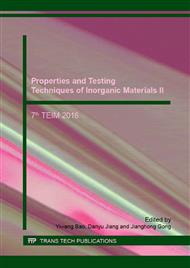[1]
D. R. Powers, Kinetics of SiCl4 Oxidation, Journal of the American Ceramic Society. 61(7-8)(1977) 295-297.
Google Scholar
[2]
G. D. Ulrich, Theory of Particle Formation and Growth in Oxide Synthesis Flames, Combustion science and Technology. 4(1971) 47-57.
DOI: 10.1080/00102207108952471
Google Scholar
[3]
H. Change, J. Park, H. D. Jang, Flame synthesis of silica nanoparticles by adopting two-fluid nozzle spray, Colloids and Surfaces A: Physicochem. Eng. Aspects 313–314 (2008) 140–144.
DOI: 10.1016/j.colsurfa.2007.04.083
Google Scholar
[4]
D. Kilian, S. Engel, B. Borsdorf, Spatially resolved flame zone classification of a flame spray nanoparticle synthesis process by combining different optical techniques, Journal of Aerosol Science. 69(2014) 82–97.
DOI: 10.1016/j.jaerosci.2013.12.002
Google Scholar
[5]
J. R. Bautista, R. M. Atkins, The Formation and Deposition of SiO2 Aerosols in Optical Fiber Manufacturing Torches, Journal of Aerosol Science. 22 (5) (1991) 667-675.
DOI: 10.1016/0021-8502(91)90019-e
Google Scholar
[6]
G. M. Graham, M. K. Alam, Experimental study of the Outside Vapor Deposition process, Aerosol Science and Technology. 15 (1991) 69-76.
DOI: 10.1080/02786829108959514
Google Scholar
[7]
C. A. Harper, Handbook of ceramics, glass, and diamonds, New York City: McGraw-Hill, 2001, 657-662.
Google Scholar
[8]
W. V. Drasek, O. Charon, R. Roux, Modified sodium line reversal Temperature Measurements in Oxy-fuel Flames, The SPIE Conference on Advanced Sensors and Monitors for Process Industries and the Environment, 1998, pp.226-232.
DOI: 10.1117/12.337480
Google Scholar
[9]
A. G. Gaydon, Flames, Their Structure, Radiation, and Temperature, 4th edition, London: Chapman & Hall, 1979, pp.155-169.
Google Scholar
[10]
N. Fujisawa, T. Abe, T. Yamagata, Flickering characteristics and temperature field of premixed methane/air flame under the influence of co-flow, Energy Conversion and Management. 78 (2014) 374–385.
DOI: 10.1016/j.enconman.2013.10.059
Google Scholar
[11]
N. Tiwari1, S. N. Sahasrabudhe1, A. K. Tak1, Measurements of Flame Temperature of Energetic Gaseous Fuels using Sodium Line Reversal Technique and Emission Spectroscopy, International Journal of Engineering Research & Technology (IJERT), 4(8)(2015).
DOI: 10.17577/ijertv4is080170
Google Scholar
[12]
N. Fujisawa, J. Yamada, T. Yamagata, Measurement of Three-Dimensional Temperature Field of Flickering Premixed Flame with and without Coflow, Flow Turbulence Combust. 93 (2014) 723–739.
DOI: 10.1007/s10494-014-9568-y
Google Scholar
[13]
D. Lee, M. Choi, Coalescence enhanced Synthesis of Nanoparticles to Control Size, Morphology and Crystalline Phase at high Concentrations, Journal of Aerosol Science. 33 (2002) 1-16.
DOI: 10.1016/s0021-8502(01)00155-0
Google Scholar
[14]
J. Cho, M. Choi, Determination of number density, size and morphology of aggregates in coflow diffusion flames using light scattering and local sampling, J. Aerosol Sci. 139(2000) 1077-1095.
DOI: 10.1016/s0021-8502(99)00574-1
Google Scholar
[15]
S. Shekar, M. Sander, R. C. Riehl, Modelling the flame synthesis of silica nanoparticles from tetraethoxysilane, Chemical Engineering Science. 70 (2012) 54–66.
DOI: 10.1016/j.ces.2011.06.010
Google Scholar


